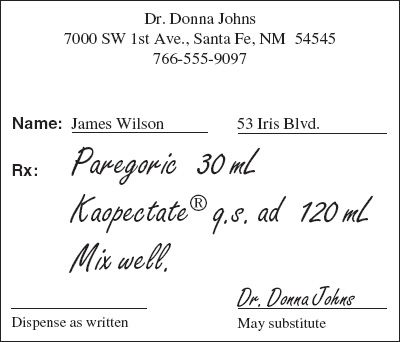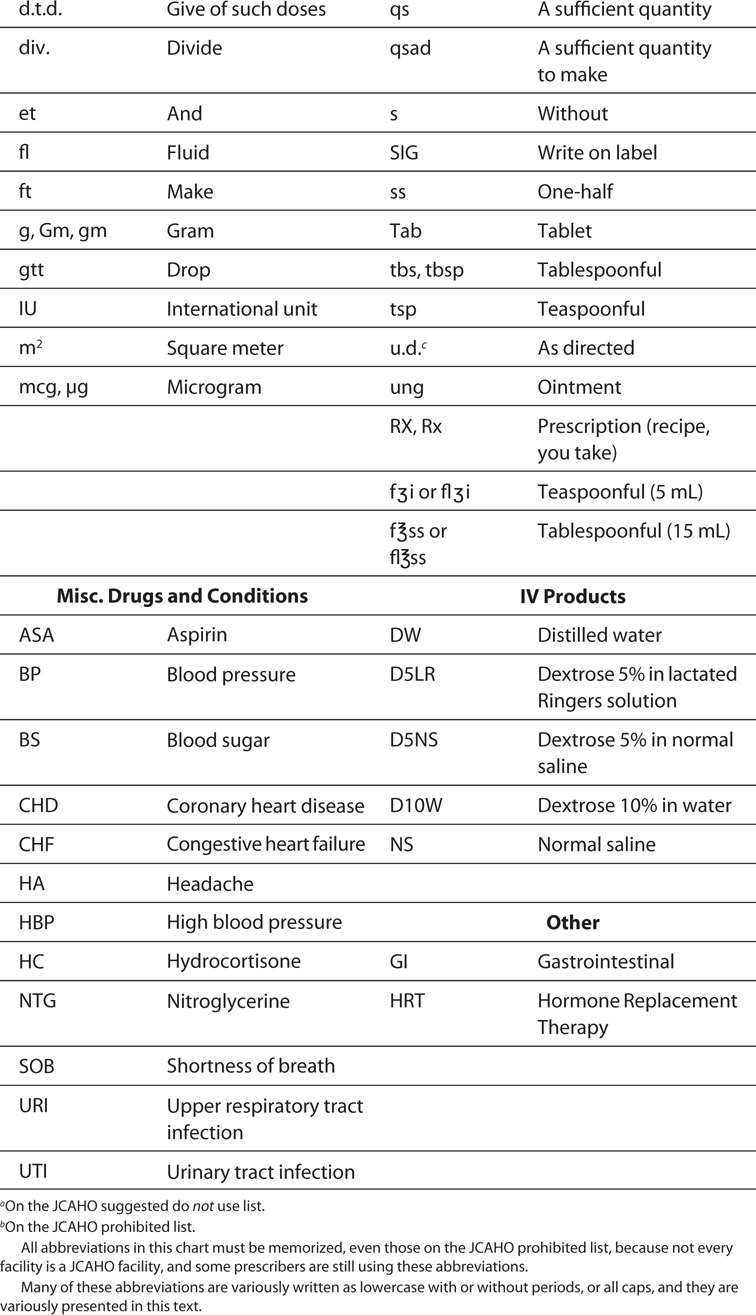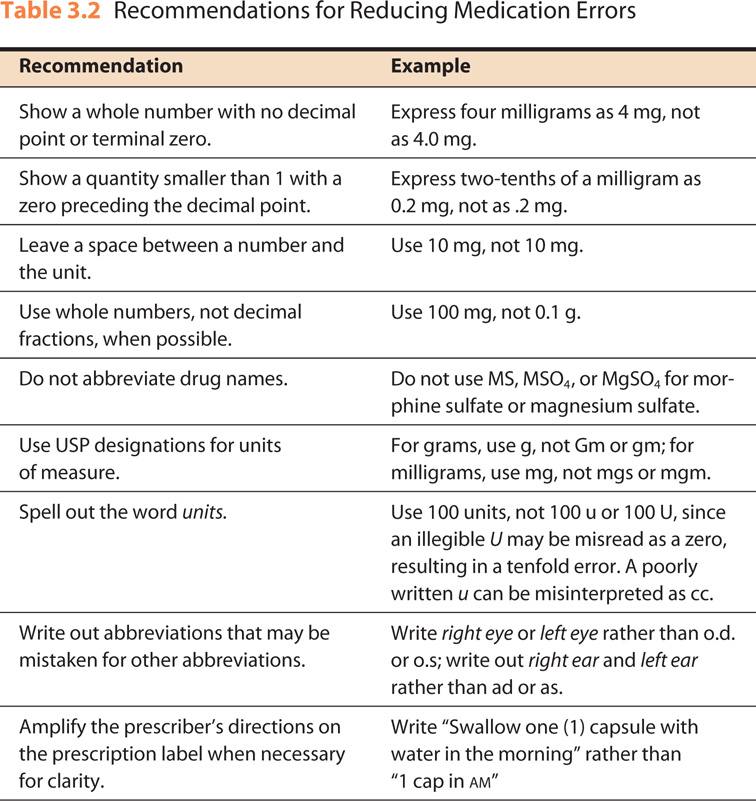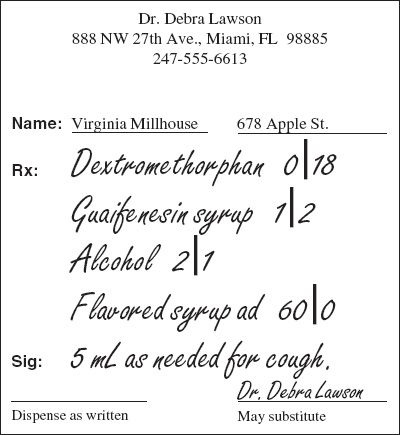TERMS
• Capsule
•Drug delivery system
•Medication administration record
•Medication order
•Patient compliance
•Prescription (or prescription order)
•Syrup
•Tablet
OBJECTIVES
Upon completion of this chapter, the technician student will be able to:
•Define medication and prescription orders.
•Identify the components of medication orders.
•Identify the components of prescription orders.
•Interpret standard abbreviations used in medication and prescription orders.
•Interpret medication and prescription orders.
•Determine patient compliancy.
 Overview
Overview
This chapter reinforces the importance of recognizing the completeness of medication and prescription orders and of knowing the common abbreviations in medication and prescription orders.
Prescriptions (also called prescription orders) are usually written on preprinted forms containing the traditional symbol Rx (meaning recipe, take thou, or you take), name, address, telephone number, and other pertinent information regarding the physician or other prescriber. In addition, blank spaces are used by the prescriber to provide information about the patient, the medication desired, and the directions for use. The information generally found on a completed prescription is shown in Figure 3.1. Prescriptions written by veterinarians generally include the animal species and/or pet’s name and the name of the owner.
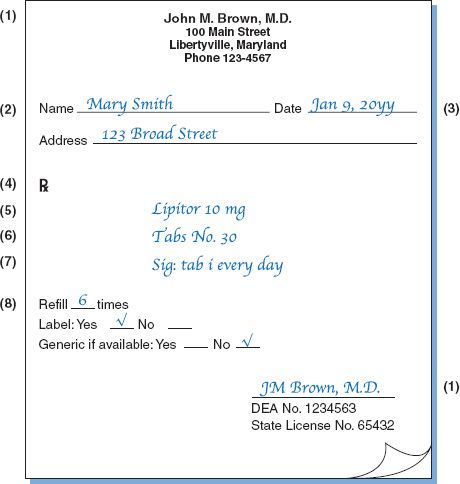
Figure 3.1Components of a typical prescription. Parts labeled are as follows: (1) Prescriber’s information and signature; (2) patient’s information; (3) date prescription was written; (4) RX symbol (the superscription), meaning take thou, you take, or recipe; (5) medication prescribed (the inscription); (6) Dispensing instructions to the pharmacist (the subscription); (7) directions to the patient (the signa); (8) special instructions. For any Medicaid or Medicare prescription and according to individual state laws, a handwritten language by the prescriber, such as brand necessary, may be required to disallow generic substitution.
prescription An order for medication issued by a licensed prescriber, a physician, dentist, or veterinarian, for example, designating specific medication, dose, and dose rate to be prepared by a pharmacist and dispensed to the patient.
In addition to the written form, prescription orders are frequently received by the pharmacist or in some states the technician, by telephone or by direct communication. In these instances, the pharmacist or technician immediately reduces the order to a properly written form or computer entry. Figure 3.2 shows a pharmacy technician entering prescription information into a computer to generate a label for the medication.

Figure 3.2A pharmacy technician entering prescription information into a database so she can create a label for the medication.
In hospitals and other institutions, the forms are somewhat different and are referred to as medication orders. A typical medication order sheet, which includes the full name of the patient, the date and time the order was written, the name and dose of drug, the route of administration, and the time or frequency of dosing, is shown in Figure 3.3. Typically, these instructions are written by the physician in ink; however, these orders may be transmitted electronically, typed or written by the physician, or given orally to nursing or pharmacy.
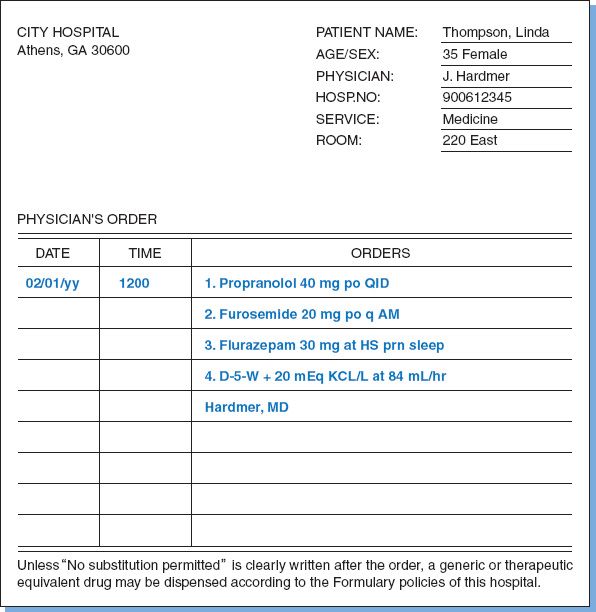
Figure 3.3A typical hospital medication order sheet.
medication administration record (MAR) A computer record of the patient’s medications, including dosage, dosage form, and route and time of administration. The MAR is prepared by the pharmacy and signed by the administrator each time a dose is given.
Any verbal order or telephone order must have the signature of the authorized health care personnel receiving that order plus the time and date the order was given. Some institutions require these orders to be countersigned by designated personnel. It is extremely important that the pharmacy technician know not only the laws pertaining to these situations, but also the policy and procedure of the institution or health care facility. In Figure 3.4, hospital pharmacy technicians have filled the medication orders and are loading the medication cart for dispensing the medication to the hospitalized patients.

Figure 3.4After filling the medication orders, pharmacy technicians who work in hospitals fill the medication dispensing cart.
A medication administration record (MAR) is a computer record of the patient’s medications, including dosage, dosage form, route or administration, and time of administration. The MAR is prepared by the pharmacy and signed by the administrator (nurse or other) each time a dose is given. The pharmacy may also have a MAR for filling the 24-hour doses required by the patient. This MAR is also used to charge and credit doses of medication the patient received.
medication administration record (MAR) computer record of thepatient’s medications, including dosage, dosage form, androute and time of administration. The MAR is prepared bythe pharmacy and signed bythe administrator each time adose is given.
Prescriptions and medication orders written for infants, children, and sometimes the elderly may also include the age, weight, and/or body surface area (BSA) of the patient (described in Chapter 7). This information is sometimes necessary for calculating the appropriate medication dosage.
Discussion of all aspects of the prescription is beyond the scope of this book. This book rather addresses only those that are relevant to pharmaceutical calculations. It is important to recognize the following types of prescriptions: (1) those written for a single component or prefabricated product and not requiring compounding or admixture by the pharmacist, and (2) those written for more than a single component and requiring compounding. Prescriptions may include the chemical or nonproprietary (generic) name of the substance or the manufacturer’s brand or trademark name. Prescriptions requiring compounding may or may not contain the quantities of each ingredient required. Medications are prepared in various dosage forms (e.g., tablets , syrups, capsules, injections) and drug delivery systems (e.g., transdermal patches) to ensure that the medication is administered accurately and appropriately. Definitions and descriptions of dosage forms and drug delivery systems are presented in the glossary.
tablet Solid dosage form containing one or more medicinal substances. Most tablets also contain other pharmaceutical ingredients, such as diluents, disintegrants, colorants, binders, solubilizers, and coatings.
syrup Concentrated aqueous solution of a sugar or sugar substitute. Syrups may or may not be medicated.
capsule Solid dosage form in which one or more medicinal and/or inert substances are enclosed within small shells of gelatin.
drug delivery system Physical carrier used to deliver medication. Examples include transdermal, ocular, and intrauterine systems.
Examples of prescriptions not requiring compounding:
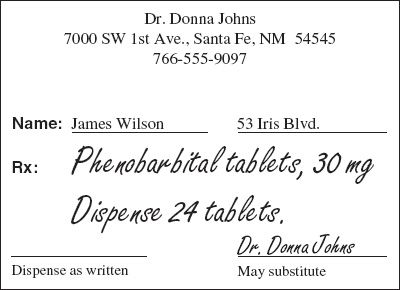
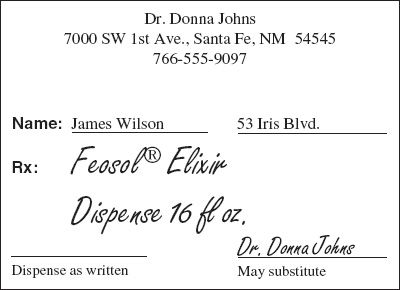
Examples of prescriptions requiring compounding:

The quantities of ingredients to be used almost always are expressed in the metric system. This system is described in detail in Chapter 2. In rare instances, units of the apothecaries’ system may be used. This system is also described in Chapter 2. In the use of the metric system, the decimal point may be replaced by a vertical line that is imprinted on the prescription blank or hand-drawn by the prescriber. In these instances, whole units or subunits of grams and milliliters are separated by the vertical line. Sometimes the abbreviations g (for gram) and mL (for milliliter) are absent and must be presumed.
The use of abbreviations on prescriptions and medication orders is common. Some are derived from the Latin through its historic use in medicine and pharmacy, whereas others have evolved through prescribers’ use of writing shortcuts. A list of some of these abbreviations is presented in Table 3.1. Unfortunately, medication errors can result from the misuse, misinterpretation, and illegible writing of abbreviations, and through the use of ad hoc or made-up abbreviations. The use of a controlled vocabulary, a reduction in the use of abbreviations, care in the writing of decimal points, and the proper use of leading and terminal zeros have been urged to help reduce medication errors1–3 (Table 3.2). A misplaced or misread decimal point represents a minimum of a 10-fold error.
Some practitioners use mgm for milligram, mcg or μg for microgram, gm for gram, and lowercase 1 for liter. The gm can be misread as gr (grain). This mistake can be avoided by familiarity with medications commonly expressed in grains. Periods in the abbreviations q.d., q.o.d., and q.i.d. have been misread as i. If q.d. is misread as qid, the patient’s medication is quadrupled. The pharmacy technician must be alert when interpreting drug orders.
Examples of prescriptions written in the metric system:
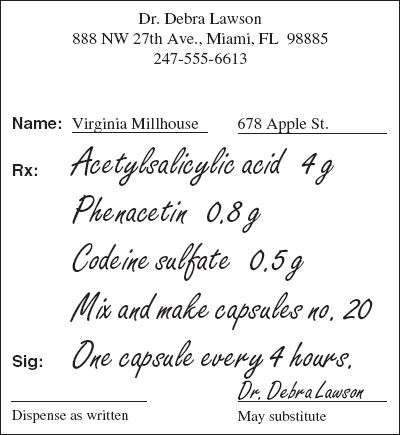
The portions of the prescription presenting directions to the pharmacist (the subscription) and the directions to the patient (the signa) commonly contain abbreviated forms of English or Latin terms as well as Arabic and Roman numerals. The correct interpretation of these abbreviations and prescription notations plays an important part in pharmaceutical calculations and thus in the accurate filling and dispensing of medication.
Although it is described fully in Chapter 2, it should be noted here that when appearing in the signa, 3i, 5 mL, and the abbreviation tsp are each taken to mean one teaspoonful; and ![]() ss, 15 mL, and the abbreviation tbs are each taken to mean one tablespoonful.
ss, 15 mL, and the abbreviation tbs are each taken to mean one tablespoonful.
Examples of prescription directions to the pharmacist:
a.M. ft. ung.
Mix and make an ointment.
b.Ft. sup. no xii
Make 12 suppositories.
c.M. ft. cap. d.t.d. no. xxiv
Mix and make capsules. Give 24 such doses.
d.qsad
a sufficient quantity to make
Examples of prescription directions to the patient:
a.Caps. i q.i.d. p.c. et h.s.
Take one (1) capsule four (4) times a day after each meal and at bedtime.
b.gtt. ii o.d. q.d. a.m.
Instill two (2) drops in the right eye every day in the morning.
c.tab. ii stat tab. 1 q. 6 h. × 7 d.
Take two (2) tablets immediately, then take one (1) tablet every 6 hours for 7 days.
A list of abbreviations commonly used in prescriptions and medication orders is presented in Table 3.1.
Review Set 3.1: Prescription Abbreviations
Interpret the following abbreviations:
1.tid
2.ac
3.c
4.qs
5.q 6h
6.IM
7.po
Give the abbreviation for each of the following:
8.after meals
9.of each
10.freely, as desired
11.a sufficient quantity
12.teaspoonful
13.four times a day
14.milliequivalent
15.ointment
